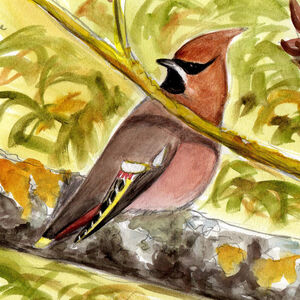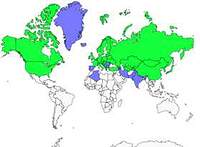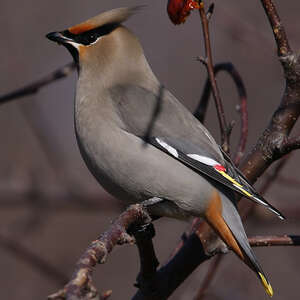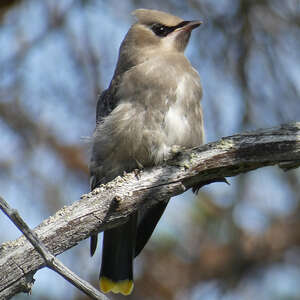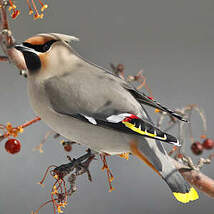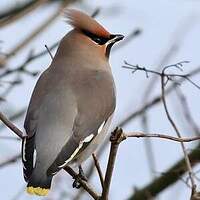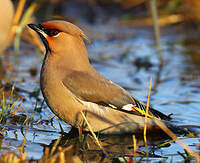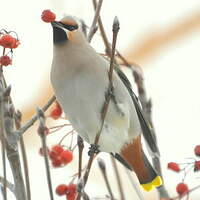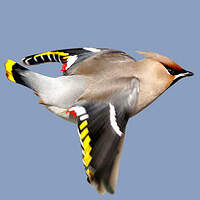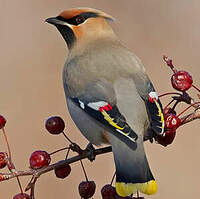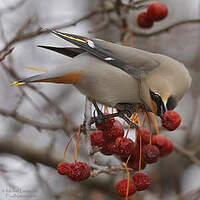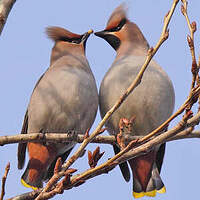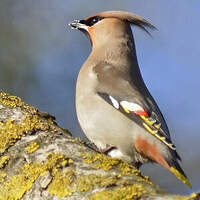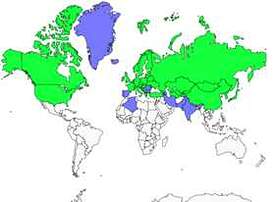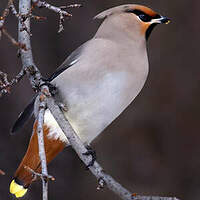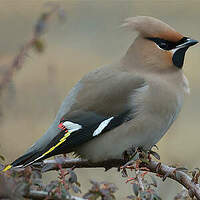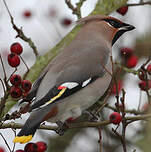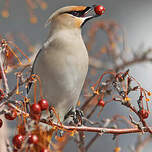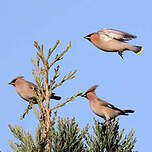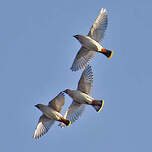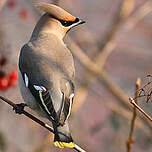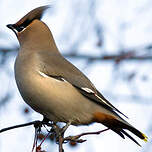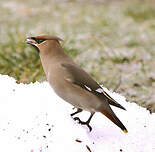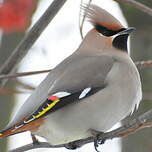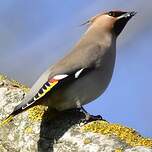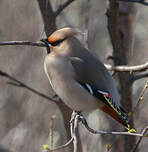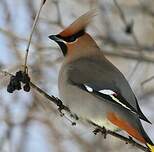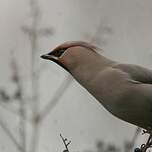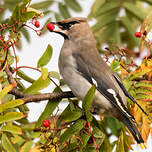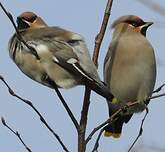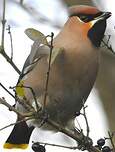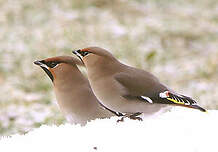Bohemian Waxwing
Bombycilla garrulus - Jaseur boréal
Identification
The Bohemian Waxwing has a size, shape and flight similar to the European Starling, with which it can easily be confused from a distance, especially as it is gregarious like it, but close observation will soon separate them. The plumage is light and the beak is short. The most obvious thing is the long erect crest, often raised on the head. The face is heavily contrasted. A black band from the forehead engulfs the dark eye and continues to the nape. The throat is also black. The front of the cap and cheeks is reddish. A white patch can be seen at the corner of the bill and a white stripe outlines the eye. The bi-coloured beak is rather short and thick. The mantle and wing coverts are brownish-beige, turning to light grey on the back, rump and upper tail coverts. The underside is beige, slightly tinged with salmon at the neck and chest. The underbelly is white, strongly contrasting with the chestnut undertail coverts.
The wings and tail are striking. Black primary feathers end in white and yellow, grey secondaries in white and bright red. A white band crosses the wing at the level of the big coverts. The short tail, grey at the base and then black, is ended in yellow, as if the bird had dipped its rectrices in a paint pot.
Sexual dimorphism is subtle. The female has less yellow at the end of the tail, less white on the primary feathers, less red on the secondaries; the throat black is less well-defined, etc.
The juvenile has a duller, more grey plumage, without the subtle pink or red shades which characterise the adult's. It is also less uniform, striped in brown on the lower parts. The throat is white. The facial mask is narrower, the crest shorter, the yellow of the wing paler and the tail less wide than the adult's.Only when they reproduce does this become visible, before post-juvenile molt. After the first molt, the young bird looks quite similar to an adult but its plumage lacks luster. It can berecognized mainly by its primary wing feathers where the outer yellow vane is less developed and paler, and there is no white inner vane. It's quite subtle.
Subspecific information 2 subspecies
- Bombycilla garrulus garrulus (n Europe and n Asia)
- Bombycilla garrulus pallidiceps (w Canada and n and w USA)
Foreign names
- Jaseur boréal,
- Ampelis europeo,
- picoteiro-comum,
- Seidenschwanz,
- csonttollú,
- Pestvogel,
- Beccofrusone,
- sidensvans,
- Sidensvans,
- chochláč severský,
- brkoslav severní,
- Silkehale,
- tilhi,
- ocell sedós comú,
- Silkitoppa,
- jemiołuszka (zwyczajna),
- zīdaste,
- pegam,
- Свиристель,
- キレンジャク,
- 太平鸟,
- sidensvans,
- 黃連雀〔黃尾太平鳥〕,
Voice song and call
Habitat
In the summertime, the Bohemian Waxwing is a typical migratory bird of the taiga, a subarctic coniferous forest bordering the south of the tundra.
Behaviour character trait
The Bohemian Waxwing is a gregarious species. This character allows loose colony reproduction. In the interseason, it moves in large groups, sometimes with as many as several thousands of individuals.
It is a not so shy bird, a feature also shared with other northern species which can be linked to the wild nature of the forests it inhabits. It is easily approachable, making it possible for some beautiful observations, particularly in urban parks which it frequents in winter.
It is a great lover of small fruits, thus is highly dependent on natural conditions for its survival. In years with bad fructification of the trees which feed it, it is obliged to set off in large numbers towards the south in search of food. These sporadic, unpredictable appearances outside of its normal range are probably the reason for popular beliefs which make it a harbinger of plague, as that one also appears unexpectedly. Thus, in Germany, it is called Pestvogel.
Flight
Dietfeeding habits
The diet of the Bohemian Waxwing is mainly insectivorous and frugivorous. During the breeding season, it is quite varied, mainly insectivorous (insects and their larvae, spiders, small mollusks, etc.
but the bird also feeds on fruits and other vegetable items (buds, flowers, moss and lichen fructifications, tree sap, etc.). The insects are sought on the ground and in the vegetation but can also be collected in flight. As for the fruits, they are taken directly in situ but can also be taken on the ground. In the interbreeding period, the frugivorous regimen becomes exclusive, which makes the species dependent on the fruiting of certain trees and shrubs, hence its occasional well-known irruptions south of its usual range in case of shortage of small fruits.Reproduction nesting
The monogamous species nests in isolated couples or small loose colonies. The only nesting occurs late in the spring.
During the wedding procession, the male offers a gift to the female, a berry, an ant nymph or something else, which the partners turn back and forth without swallowing it. The nest is a cup built on a horizontal conifer branch, between 2 and 15 meters from the ground. It is made of twigs, grass, mosses and lichens, and lined with feathers or hairs inside. The female lays 3 to 7 eggs there. Incubation lasts about two weeks. The young are fed at the nest for a fifteenth of days by regurgitating insects and berries.Geographic range
The Bohemian Waxwing is a Holarctic boreal species. Its nesting range extends throughout Eurasia, from Scandinavia to eastern Siberia and Kamchatka, and across northern America, from the Bering strait to the Hudson Bay. The Bohemian Waxwing is a partial migrant. Its wintering range is further south, mostly overlapping with the breeding range. The species is an occasional winter visitor to France during irregular invasions.
Threats - protection
Sources of information
- IOC World Bird List (v14.2), Gill, F and D Donsker (Eds). 2024-04-18.
- HBW Alive,
- xeno-canto, Sharing bird sounds from around the world,
Other sources of interest
 Specification sheet created on
25/07/2023 by Jean François
Specification sheet created on
25/07/2023 by Jean FrançoisTranslation by AI Oiseaux.net
© 1996-2025 Oiseaux.net
- Accipitriformes
- Aegotheliformes
- Anseriformes
- Apodiformes
- Apterygiformes
- Bucerotiformes
- Caprimulgiformes
- Cariamiformes
- Casuariiformes
- Charadriiformes
- Ciconiiformes
- Coliiformes
- Columbiformes
- Coraciiformes
- Cuculiformes
- Eurypygiformes
- Falconiformes
- Galliformes
- Gaviiformes
- Gruiformes
- Leptosomiformes
- Mesitornithiformes
- Musophagiformes
- Nyctibiiformes
- Opisthocomiformes
- Otidiformes
- Passeriformes
- Pelecaniformes
- Phaethontiformes
- Phoenicopteriformes
- Piciformes
- Podargiformes
- Podicipediformes
- Procellariiformes
- Psittaciformes
- Pterocliformes
- Rheiformes
- Sphenisciformes
- Steatornithiformes
- Strigiformes
- Struthioniformes
- Suliformes
- Tinamiformes
- Trogoniformes

